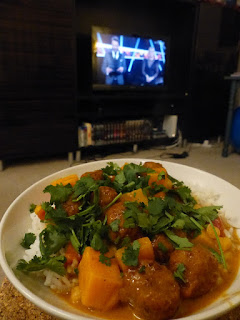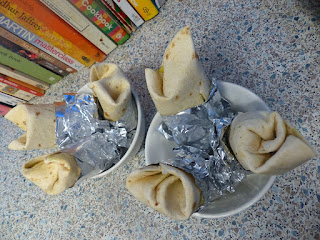In case you missed it, you can read all about the starter and main course from the January menu here. In that post, I talk about how the third and final element of the meal merited separate attention. I stand by that assessment - and so we now turn to:
◘ THE DESSERT ◘
The book: Everyday Novelli (Jean-Christophe Novelli)
The recipe: p119, "Hot Apricot Flan"
Yes, to no one's great surprise, it's a Novelli creation that demands a post of its own. So far, Everyday Novelli has delivered us liquidy, garlicky hummus, the prospect of porridge-fed mussels, a surprisingly good dinner that would have been significantly less good if I hadn't intervened and refused to use an entire litre of double cream in its preparation... oh, and there was something about swans too.
Accordingly, my hopes are not high when the random finger of fate lands on our friend Jean-Christophe again. Especially since the introductory paragraph to this "hot" dessert concludes with the instruction "Serve hot or cold". With this level of attention to detail, I can already sense it's going to be one of those days.
I'm going to start with a confession here: I skim-read the recipe, saw flour among the ingredients, and idly assumed this "flan" would be of the "sweet tart with a base and a rim" variety. Reader, it is not. In the absence of condensed milk or a preponderance of egg yolks, however, neither it is a pudding in the sense of a crème caramel/custard/birthday flan. Quite what it is supposed to be, I'm still not entirely sure even now I've made the thing, to be honest.
Anyway, we kick off with a bit of preparation: Canned apricot halves are drained, placed in a bowl, and left to macerate in a little kirsch for an hour. Or they would be if we had any kirsch in the house, but there's no obvious reason we would and I'm not sourcing a whole bottle of the stuff during a lockdown just so I can sprinkle a thimbleful over some apricots, so I use sugar and a splash of wine to approximate a similar softening effect.
Once that's done, I can prepare my flan tin. Novelli calls for a 22cm tin. The two circular dishes I own - a regular deep pie/quiche dish, and a loose-based metal tin - are both around 28cm in diameter, so either way the end result here is going to be a bit shallower than what J-C has in mind, but it should be easy enough to tweak the cooking time if necessary. Since I'm still working on the assumption that this will be a pie-like creation that might benefit from being turned out onto a plate once it's done, I opt for the metal tin.
This is greased with butter and left to chill in the fridge for five minutes. It then gets taken out, greased with more butter, then dusted with a mixture of caster sugar and cocoa powder before being returned to the fridge for a further 20 minutes.
 |
| Seems like a lot of effort, but okay |
What's going into that lovingly prepared tin, anyway? Let's see. I mix together some demerara sugar, vanilla, a little softened butter, a pinch of salt, 100ml of honey and four eggs. I then sift in 250ml of flour and beat it all together until it has a batter-like consistency.
To me, that already feels like the kind of thing you could pour into a dish and bake until it's nice and set and wobbly. So I am beyond bemused when the next step requires me to add 600ml of milk and 400ml of double cream.
I'll say that again: a litre of liquid.
This is the exact moment at which I become aware that: (a) this is not going to be a pie; (b) this is going to be fucking terrible.
Under normal circumstances I'd assume the recipe to be correct - people do test and proofread these books, right? - but we have very recent evidence of a Novelli recipe that quite clearly involved way too much cream to be edible and no one appears to have picked up on the error, so there's every chance the quantities are off here, too. Should it be 60ml and/or 40ml? Maybe it should. The trouble is - unlike with a savoury meal, where I'm experienced enough to make an executive decision and do things differently - I'm not brilliant with desserts so I can't really improvise and know for sure that I'm still going to end up with something that's in keeping with the spirit of the recipe.
So instead I beat in a litre of milk and cream.
 |
| Great |
This goes into the fridge to "rest" for 20 minutes. I have a faint hope that this might thicken the mixture somewhat, but of course it doesn't. I'm not sure even freezing it would do much to thicken it, frankly...
Next it's time for assembly before my "flan" goes into the oven for 15-20 minutes. (Incidentally, Novelli wanted me to preheat the oven before doing all of the above. I remain convinced that cookbook authors are in cahoots with power companies to drive up their profits.)
My suspicions about the accuracy of the quantities are further confirmed when it becomes evident that there is way too much liquid here to comfortably fit into my tin, even though it's 6cm wider than the one Novelli recommended. Not only that, but the recipe also calls for me to "spoon in" the filling. Mine doesn't require any kind of spooning; it can be poured. So, yep - definitely a bit sus.
Now, remember those apricots from earlier? They're in the recipe name, so it's about time for them to become relevant again. I grab the bowl in which they've been macerating and toss them in 30ml of honey before arranging them on top of the filling. Why the honey? Allow me to quote from the recipe: "This coats the fruit and helps to prevent it from sinking."
Bear that in mind as I share this next photo:
Have a close-up for good measure:
There's not much "arrangement" involved here, for fairly obvious reasons. As well as enveloping the apricots entirely, you'll note that the liquid nature of the filling means some attractive globs of coagulated cocoa powder have floated to the surface, so that's delightful too.
If the apricots had been sat nicely atop a thick batter at this stage, the next thing would have been to brush them with a little oil before putting the dish in the oven. Since they're barely visible and drowning a milky death, however, that feels like something of a moot point. I figure it's time to just shove this bin fire into the oven and see what happens.
And that's when I notice the filling starting to leak out of the tin.
 |
| Well that's just terrific |
Now, again: If it wasn't already abundantly clear that this was going to go wrong...
You can't beat a bit of optimism even at this late stage, though, and I figure that maybe if I get it in the oven ASAP, it'll start to set around the edges before too much of the filling escapes.
That'll be a no, then. (Still, at least the fucking apricots are visible now...)
Cursing the name of Jean-Christophe Novelli loudly enough to be heard halfway to Hither Green, I decide there's nothing else for it. I quickly salvage whatever I can and unceremoniously decant it into that pie dish I mentioned earlier:
...and finally my "flan" can start baking in earnest.
By this point I have absolutely no idea what's going to come out the other side. It's clearly not going to be what the recipe thinks it's going to be, but that's been evident for a while now. Even with whole eggs and not just yolks involved, maybe it'll be something close to a giant baked custard after all? Or perhaps more of a soufflé... only with, erm, apricots in it?
Whatever it is, the sheer volume of what I've created here means the "15-20 minutes" of oven time ends up being more like 35-40 before it's sufficiently set to safely come out again. As for the end result, here it is:
To be honest, I'm just delighted it's baked enough to resemble something it might be possible to slice up. And cutting it open does reveal some kind of structural integrity, even if it's not necessarily the most appealing of cross-sections.
"Allow to cool for 15-20 minutes", the recipe says - again, I would remind you that this is called "Hot Apricot Flan" - then serve "with scoops of vanilla ice cream".
 |
| Can do. |
What to say about this month's dessert, then? Well, despite everything, it's not terrible. It's got cream and sugar and eggs in it, after all - how bad can it be?
The problem is you can tell the proportions are all off: it's not sweet enough, what with the sugar having been diluted by so much dairy, and the consistency is more gloopy than springy, making it borderline unpleasant after a few spoonfuls. If anything, it's reminiscent of stodgy 1980s school dinners, and that cannot possibly be what's intended. Still, you can conceal a multitude of sins under a dollop of ice cream, and I have to report that we do end up eating the whole thing over several days. Just not necessarily with vast amounts of enthusiasm. As Sam puts it, "it's fine, but you wouldn't serve it to someone...".
Ultimately, I would be fascinated to know what is wrong with this recipe - specifically, exactly how much milk and cream should be involved - because there's clearly a decent idea in there somewhere, it's just been thoroughly bludgeoned by a lack of care and attention. Much like everything else I've tried from Everyday Novelli so far.
Sam's conclusion is that I should just give the book to a charity shop, considering how badly things go every time I dip into it. But I don't think I can. Firstly, I secretly quite enjoy these kitchen disasters and the sheer disdain I feel towards Jean-Christophe Novelli as a result. And secondly, I'm not sure I could sleep easily knowing that someone else was having to suffer like this...
One-word verdict: Fucksake.





























 The book: Good Housekeeping New Step-by-Step Cookbook
The book: Good Housekeeping New Step-by-Step Cookbook





 The book: 101 Cheap Eats (BBC Good Food)
The book: 101 Cheap Eats (BBC Good Food)






 The book: Curry Easy (Madhur Jaffrey)
The book: Curry Easy (Madhur Jaffrey)










